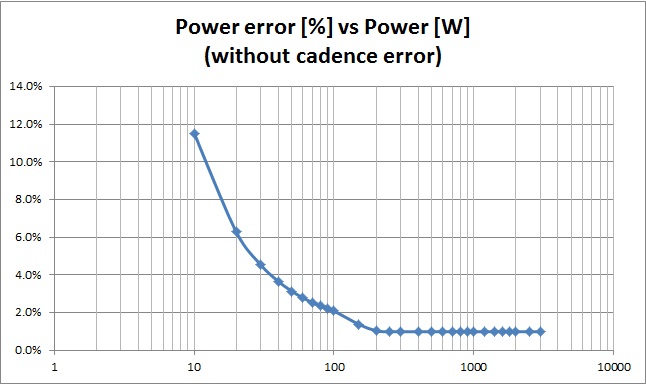As far as I know, Verve cycling is the only power meter manufacturer that publishes somewhat trustable accuracy specifications:
- Power range: 0–3000 Watts
- Cadence range: 10–200 rpm
- Accuracy of cadence: ±1 rpm
- Accuracy torque: ±0.2 Nm accuracy for measurements below 20 Nm, and ±1% of actual readings for measurements above 20 Nm (ask for our Accuracy Certification)
- Power: Can be calculated from any cadence value within the range at any torque
- Power update rate: Every rotation
Surprisingly, even SRM only gives one single number, although added with a blunt statement:
Accuracy ±1% (Scientifically Proven)
No proper scientist would state an error number like ±1% without specifying for what range of conditions that number is valid. So much about science.
Assuming cadence as a function of power:
the specifications of verve systems gives this error:
which translates into W like this:
In other words: Verve cyclings’s Infocrank has an accuracy of about 2% above 110W (like most other power meters) and about 5% or 2W at 50W. Well, that doesn’t seem really significant to me, but still: hiding (including just forgetting to mention) such a fact doesn’t seem right either, and I strongly feel that since most power meters are engineered using somewhat similar principles, a lot of manufacturers have some clarifications to make.
(added new section from here on)
The interesting point here might actually be: How did I get from a 1% torque error to a 2% power error, if power and torque are related linearly?
Now we see: without cadence error, 1% torque error of course results in 1% power error, but a cadence error of just 1 rpm (or 1% at cadence 100!) will add another 1% to the power error. So, if you have a cadence sensor with an absolute 1 rpm error range, you’d want to pedal quickly to get more accurate power figures …. well, that’s just a joke, but, measuring rotation accurately is a really important factor here, and the more wheel rotations of a hub-based power meter compared with crank- = pedal-rotations would make a hub-based meter easier to engineer for high accuracy.
(I hope I didn’t make any calculation errors and would be happy to be corrected.)



